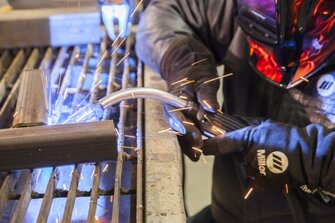MIG Welding Glossary: Terms To Know
Estimated reading time: 3 minutes
Welders use MIG welding in many industries — fabrication, manufacturing, shipbuilding and rail to name a few. While it is a common process, it requires attention to detail, and it is helpful to know some key terms associated with it. As with any process, the better the understanding, the better the results.

Bird-nesting
The tangling of welding wire in the drive rolls of the wire feeder. This typically happens when the wire doesn’t have a smooth feeding path due to a liner being cut too short, the wrong size liner or tip being used, or incorrect drive roll settings. Resolve this issue by trimming the liner properly and ensuring that the feed path of the wire is as smooth and straight as possible.
Burnback
Occurs when the wire melts inside the contact tip before reaching the workpiece. It results from incorrect contact-tip-to-work distance (CTWD) — the distance between the end of the tip and the base metal — or a too-slow wire feed speed (WFS). It can also be caused by incorrectly trimmed liner and incorrect parameters. Remedy the problem by increasing WFS, adjusting CTWD, trimming the liner according to the manufacturer’s recommendation and modifying weld parameters.
Deposition rate
Refers to how much filler metal is deposited into a weld joint over a specified period of time, measured in pounds or kilograms per hour (lbs/hr or kg/hr).
Discontinuity
A flaw in the structure of a weld that does not pose a risk of failure. It differs from a weld defect that can affect the integrity of a weld once in service.
Duty cycle
Refers to the percentage of time in a 10-minute period a gun can be used at a specific amperage (arc-on time) without becoming too hot to handle or overheating. A gun’s duty cycle is affected by the type of shielding gas being used for welding. For example, a MIG gun may be rated at 100% duty cycle with 100% CO2 shielding gas, meaning it can weld the entire 10 minutes without issues; or it could have a gun rating of 60% duty cycle with mixed gases.
Electrode extension
The distance the welding wire extends from the end of the contact tip to where the wire melts. As electrode extension increases, amperage decreases, which reduces joint penetration. Also commonly referred to as tip-to-workpiece distance.
Heat-affected zone
Often referred to as HAZ, it is the portion of the base material surrounding the weld that hasn’t melted but has had its properties changed at a microstructure level due to the heat input. Cracking can occur here.
Incomplete fusion
Also called lack of fusion, it occurs when the weld fails to fuse completely with the base material or a previous weld pass in multi-pass welding. Typically, it is the result of an incorrect MIG gun angle.
Porosity
A cavity-like discontinuity that occurs when gas becomes trapped in the weld upon solidification of the molten weld pool. It is most often caused by poor shielding gas coverage or base material contamination.
Weld penetration
Refers to the distance the weld fuses below the surface of the base material. Incomplete weld penetration occurs when the weld doesn’t completely fill the root of the joint.
This is the second article in a three-part series on welding basics. Read article one, MIG Welding Basics and article three, MIG Welding Techniques: What to Know.